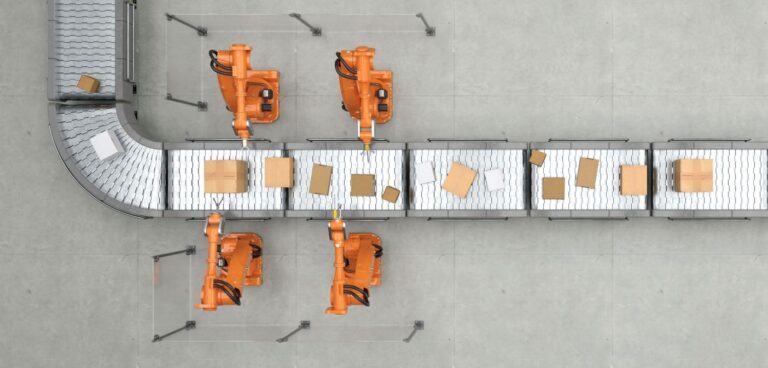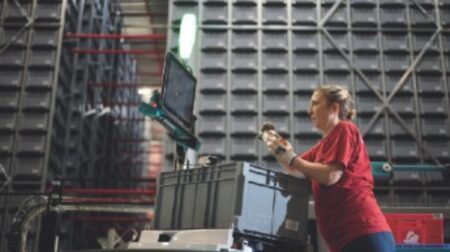Maria Highland learns how warehouses are turning to automation to improve order fulfilment as retailers continue to react to the effects of the e-commence boom…
Where consumers have had to shop online during Covid-19 has caused a permanent shift in buying habits and sped up the growth of e-commerce almost overnight. As a result, the way many warehouses and distribution centres operate has changed dramatically – many warehouses now ship directly to customers, only to receive almost the same number of items back as they send out, creating volatile product flows.
“Warehouses and distribution centres now have to deal with an entirely different process,” says Gregor Baumeister, warehousing and distribution director at Beumer Group. “It involves vast numbers of customers who order just one or two items and it’s unpredictable. It also means that warehouses and distribution centres are now performing tasks previously managed by retailers, such as distinguishing between item sizes and colours for B2C order fulfilment.”
Such shopping habits are showing no sign of yielding, therefore retailers are “continuing to see increasing volumes, managing deliveries and returns, while trying to ensure accuracy and improve sustainability, as major warehouse challenges,” says David Carroll, chief executive at Breathe Technologies.
To address challenges and meet consumer expectations, retailers are turning to sortation technology to improve order fulfilment. “We’re seeing a rise in need for solutions such as pouch systems for managing multi-item orders,” says Carroll. “This technology accelerates multi-choice orderings, as well as optimising single-piece outbound and returns handling, to decrease order lead time and availability of returns.”
“This specialised technology, which is able to transport, sort, sequence and store both outbound and returned items, is now becoming the centrepiece and fulfilment engine for warehouses and distribution centres dealing with both B2B and B2C,” adds Baumeister. “Warehouses and distribution centres can streamline several handling processes by using a pouch system; regular sorting after picking, batch sortation and intermediate storage and handling for reverse logistics.”
Flexible perspective
However, the gamechanger is the technology behind sortation, says Baumeister: “The common denominator is flexible automation, which enables each of these processes to be completed with less manual handling.”
Despite the turmoil and disruption cause by Covid-19, the pandemic has provided businesses with opportunities to grow their e-commerce offering. “These factors, along with labour availability issues, underscore the very real need businesses now have for highly flexible, low-cost automation – and this often means taking a new approach to sortation, using innovative technologies,” says Nick Hughes, sales manager, Invar Integration.
Indeed, automation is helping to address a wide range of challenges and has the potential to improve operations dramatically – when applied correctly. Therefore, businesses need to consider various factors before investing in automated sorter and conveyor technology.
Honeywell Intelligrated’s Buried by E-commerce? Expand Sortation Capacity to Keep Up whitepaper acknowledges that “e-commerce fulfilment operations face the universal mandate to scale up sortation capacity appropriately. This leads to a matchmaking game, in which success depends on finding the optimal automated sortation solution to meet operational requirements.”
First and foremost, businesses need to gain an understanding of key information about orders, such as the number handled per day and the packaging types, according to Honeywell. Such information is crucial because, for example, “lighter-weight packages cost less to ship yet create additional catch points that increase the chances of sortation conveyor jams or sortation loop recirculation”. Therefore, an organisation’s choice of sortation system will depend on its ability to handle specific types of packaging.
Businesses also need to consider outcome of the sort as this will govern which sortation technology is most suitable. For example, loop sortation technology, such as a cross-belt sorter, is best used for warehouses with a large number of sort destinations in a limited space. This “allows items to travel around the loop while awaiting other picks required by the same order to arrive prior to pack-out,” states Honeywell. Line sortation, such as a sliding shoe sorter, is best for those wanting to sort items to the proper shipping trailer as they leave the facility.
Finally, “with the high order volumes of e-commerce putting stress on the capacity of existing systems, throughput rates at both standard and peak periods are critical considerations when selecting the most optimal automated sortation technology,” according to Honeywell. “Throughput rates can fuel return on investment calculations, as well as provide room for operations to scale for the future — a critical consideration for maximising long-term value.”
Bigger picture
When looking to invest in sortation and conveyors, it is imperative to select a solution that will complement the rest of a warehouse’s operations. This requires taking a more holistic approach, particularly as investing in new technology doesn’t come cheap. “To maximise your return on investment, it’s important to invest in systems and technology that will ensure the longevity of the facility – in terms of design, size, storage capacity and function,” says Baumeister.
Business should take the time to map out current and future business needs and, to ensure their material handling automation is not obsolete in a few years’ time, to plan the system design. Likewise, businesses need to consider their processes. “This means looking at their needs and asking where and why bottlenecks are occurring in their systems,” says Baumeister. “Is it an issue of speed, staffing, costs, storage or handling returns?”
By mapping out the system, “supply chain managers will end up with an individual approach that best fits their specific needs and is future-proof,” says Baumeister. In turn, this allows managers “to pick the parts of their processes that should actually be automated by determining which aspects would value-add the most to their particular situations.”
Taking a holistic approach when implementing automation also means looking at how the sortation and conveyor systems will interact with other elements of the warehouse. “When looking at sortation and conveyor systems, consideration of where these processes are used within the warehouse is key,” says Carroll. For example, “consolidating items together as a pre-requisite to packing or re-stocking, then organising outbound parcels or transport units for carriers,” he says. “Enabling flexibility within systems like this will require less manual handling and reduce operational costs for sortation and returns.”
One step beyond
According to Beumer Group’s Gregor Baumeister, the next big steps for warehouses will be “to combine sorting technology with robotics and data analytics to achieve efficiencies that are beyond the current imagination of the industry”.
Baumeister believes that “pouch and robotic technology supported by data analytics holds the key to creating the warehouse of the future. The seamless integration of these technologies offers the potential to automate and optimise nearly all warehouse processes,” he says.
Alternatively, Nick Hughes at Invar Integration believes that the time for robotics is now, albeit in a slightly different way, with autonomous mobile robots (AMRs) removing the need for fixed, cross-belt sorters. “AMRs offer a low cost of entry to automation; flexible and highly scalable solutions with a return on investment that can be as short as 12 months.
“AMRs open up the possibility for automated sortation to many more businesses,” continues Hughes. “They’re fast to install, can be increased in number as needed to boost capacity and, unlike a cross-belt sorter, where belt width can be a constraint on the size of goods processed, a fleet of robots with differing capacities can offer far greater flexibility.”








